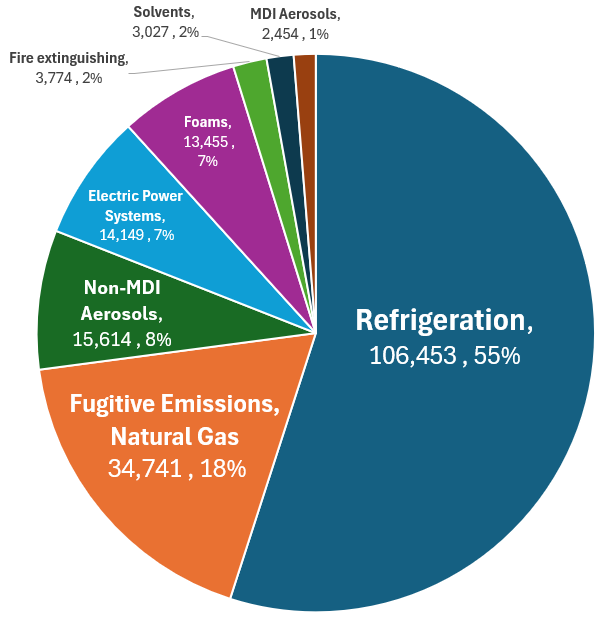E8. Process and Fugitive Emissions Inventory Results
Process and Fugitive emissions cause 0.19 MMT of CO2e, or 3% of emissions in Washoe County. Process emissions make up 0.0% (0.00 MMT) and fugitive emissions make up 100% (0.00 MMT) of this category, with Refrigeration 65% being the largest source of fugitive emissions (56%), followed by fugitive emissions from the distribution of natural gas (18%).
MT CO2e for Process and Fugitive Emissions in Washoe County, 2021

|
Fugitive Emissions in Washoe County, 2021 |
||
|
Fugitive Emission |
MT Co2E |
MMT CO2e |
|
Refrigeration - HFC125 |
44,602 |
0.0446 |
|
Refrigeration - HFC134a |
28,647 |
0.0286 |
|
Refrigeration - HFC143a |
27,409 |
0.0274 |
|
Refrigeration - HFC32 |
5,400 |
0.0054 |
|
Refrigeration - HFC236fa |
390 |
0.0004 |
|
Refrigeration - Other HFC |
5 |
0.0000 |
|
Total Refrigeration |
106,453 |
0.1065 |
|
Fugitive emissions from Natural Gas |
34,741 |
0.0347 |
|
Total Natural Gas |
34,741 |
0.0347 |
|
Non-MDI Aerosols - HFC134a |
9,056 |
0.0091 |
|
Non-MDI Aerosols - Other HFC |
6,558 |
0.0066 |
|
Total Non-MDI Aerosols |
15,614 |
0.0156 |
|
Electric Power Systems, SF6 - Commercial |
7,104 |
0.0071 |
|
Electric Power Systems, SF6 - Residential |
3,686 |
0.0037 |
|
Electric Power Systems, SF6 - Industrial |
3,359 |
0.0034 |
|
Total Electric Power Systems |
14,149 |
0.0141 |
|
Foams - Other HFC |
10,456 |
0.0105 |
|
Foams - HFC134a |
2,999 |
0.0030 |
|
Total Foams |
13,455 |
0.0135 |
|
Fire extinguishing - Other HFC |
2,531 |
0.0025 |
|
Fire extinguishing - HFC236fa |
824 |
0.0008 |
|
Fire extinguishing - HFC125 |
272 |
0.0003 |
|
Fire extinguishing - CF4 |
72 |
0.0001 |
|
Fire extinguishing - HFC23 |
43 |
0.0000 |
|
Fire extinguishing - Other PFC |
32 |
0.0000 |
|
Total Fire Extinguishing |
3,774 |
0.0038 |
|
Solvents - Other HFC |
3,027 |
0.0030 |
|
Solvents - Other PFC |
0 |
0.0000 |
|
Total Solvents |
3,027 |
0.0030 |
|
MDI Aerosols - HFC134a |
1,420 |
0.0014 |
|
MDI Aerosols - Other HFC |
1,034 |
0.0010 |
|
Total MDI Aerosols |
2,454 |
0.0025 |
|
Total Fugitive Emissions |
193,667 |
0.1937 |
Definition of Process and Fugitive Emissions: Process emissions result from physical or chemical processing rather than from fuel combustion. Examples include emissions from manufacturing cement, aluminum, adipic acid, ammonia, etc.
Fugitive emissions are not physically controlled but result from the intentional or unintentional release of GHGs. They commonly arise from the production, processing, transmission, storage and use of fuels or other substances, often through joints, seals, packing, gaskets, etc. Examples include HFCs from refrigeration leaks, SF6 from electrical power distributors, and CH₄ from solid waste landfills.
Process and Fugitive emissions in Washoe County Washoe County does not produce significant Process emissions. Heavy industrial processes cause Process emissions, and according to the EPA’s Facility Level Information on GreenHouse gases Tool (FLIGHT), no buildings in Washoe County are classified as a) large emitters, directly emitting 25,000 metric tons of CO2e or more per year, or b) suppliers of certain products that would result in GHG emissions if released, combusted, or oxidized.
There are two primary sources of Fugitive emissions. First, the natural gas production and distribution system leaks methane, a potent greenhouse gas. Second, fluorinated gases escape from industrial applications including refrigeration and air conditioning equipment, solvent cleaning, foam production, sterilization, fire extinguishing, and aerosols. These gases include hydrofluorocarbons (HFCs) and perfluorocarbons (PFCs). Sulfur hexafluoride (SF6) is another fluorinated gas that utilities use in electric power systems for voltage electrical insulation, current interruption, and other uses in the transmission and distribution of electricity. It is the most potent greenhouse gas known to-date; over a 100-year period, SF6 is 24,300 times more effective at trapping infrared radiation than an equivalent amount of CO2.
